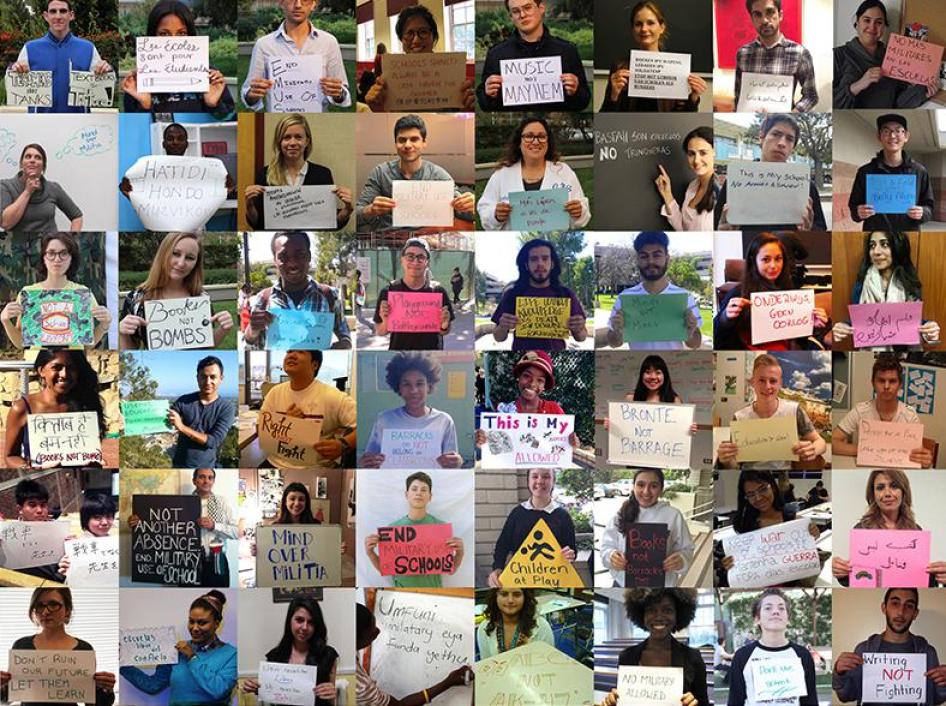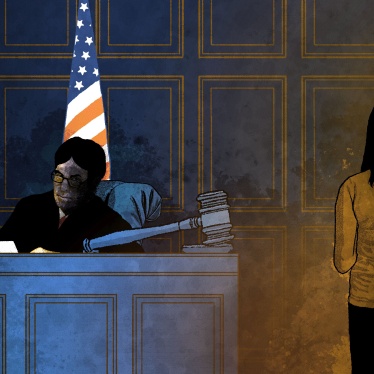Next week, Argentina will host the Second International Safe Schools Conference, to discuss implementation of the Safe Schools Declaration, opened for endorsement in May 2015. The declaration outlines concrete steps that countries and their armed forces can take to make it safer for children to pursue their education everywhere. For Human Rights Watch’s Bede Sheppard, this recent initiative reflects centuries-old principles established by rulers such as the Roman Emperor Constantine and the 17th c. Swedish King Gustavus Adolphus, which also sought to protect education from military interference.
The Safe Schools Declaration includes a commitment to better protect schools from being used for military purposes such as barracks or bases. Subsequent to the launch of the declaration, the UN Security Council encouraged all countries to take concrete measures to protect schools from such interference.
In a new report released today, Human Rights Watch has brought together examples of law, policy, and practice from 40 countries, from Afghanistan to Yemen, instituting some level of protection for schools or universities from military use.
All this sudden attention might give the impression that there’s something new about this endeavor. But a look back at history reveals there’s little new to the goal of protecting education from military interference.
A brief history of protecting education
In 333 CE, Roman Emperor Constantine reminded his subjects of something essential: education is important and therefore must be protected from the interference of accommodating or quartering soldiers.
It’s a message that humanitarians still find themselves having to remind armed forces of today, yet to Constantine a mere 1,683 years ago it was a concept already well established. Noting that he was acting only “in confirmation of the special grants of imperial favor by previous sainted emperors,” Constantine proclaimed that all professors of literature must be free from the obligation to “receive quartered persons” in order that “they may more easily train many persons in the liberal arts.”
In the following century, successive emperors, in both the Western and Eastern Roman empires, issued similar protections for teachers from having to quarter soldiers. In 427, the Byzantine emperor Theodosius the Younger and the Western Roman Emperor Valentinian III explained that such protections for professors from quartering soldiers were justified because their teaching “must be freed as long as they live from the molestation of furnishing quarters.”
Emperors Theodosius and Valentinian are also said to have prohibited metalsmiths from working near schools and the houses of professors so as not to disturb studies. Even if such a craftsperson were involved in making arms for the state — and therefore like the professors was engaged in an activity in support of the public good — education prevailed over the military necessity. The local magistrate was to assign another convenient location for the metalwork, without causing inconvenience to the scholar.
More than a millennium later, King Gustavus Adolphus, who led Sweden to military supremacy during the Thirty Years’ War, also expressed concern about protecting education. He ensured, for example, that each of his regiments had schools for the children who accompanied their soldier fathers across Europe.
In 1631, when King Gustavus captured the town of Erfurt in modern-day Germany, he exempted schoolmasters and university professors from “the disagreeableness” of having to quarter soldiers, and placed them under his own personal protection.
In the same year, perhaps following up on a promise to the Elector of Brandenburg to ensure free passage on his march to Potsdam, the king addeda new rule to his articles of war, which dictated the behavior of his troops: “Any soldier … convicted of having committed any disorder in … schools, shall be punished with death.”
A year later he found cause to add yet another rule: that “No soldier shall abuse any … colleges [or] schools … nor any way be troublesome with pitching or enquartering upon them.”
(Despite such protections, Adolphus’ Protestant soldiers appeared willing to take over Catholic schools (.pdf) for quarters when space ran out in public houses and buildings.)
The idea of protecting schools during wartime was spreading through Europe. Denmark’s Christian V decreed (.pdf) in 1683 that “children … and schools must all be protected, under heavy corporal penalty.” (p. 34).
Although such harsh penalties for wartime offenses are now thankfully prohibited, protections for civilian objects — including schools and universities — as well as for children and their education remain in today’s laws of war. Yet the practice of using school buildings for military purposes is rarely explicitly addressed in today’s military manuals and doctrine. There are examples though, and that practice appears to be increasing.
The safe schools declaration
Emperor Constantine’s decree followed the unprecedented expansion of primary education to villages and cities all over the Roman Empire during the third century. Today, we face a world where schools have spread to almost every inhabited corner of the planet, yet still are threatened by interference from soldiers.
Between 2007 and 2017, schools and universities were used for military purposes — such as for bases or deployment or as arms depots — in at least 29 countries with armed conflict, according to the Global Coalition to Protect Education from Attack, of which Human Rights Watch is a member.
That’s one of the reasons why in May 2015, a group of like-minded countries met in Oslo, Norway, to commit to doing more to protect students, teachers, schools, and universities in today’s wars. The resulting Safe Schools Declaration outlines concrete steps that countries — and their armed forces — can take to make it safer for children to go to school everywhere.
One of these commitments is to use a set of guidelines (.pdf) for armed forces to minimize the use of school or university buildings for military bases or barracks. Since using a school for military purposes can turn it into a target of attack, minimizing such use will reduce the number of schools damaged or destroyed during war, and allow more children to study in safety.
These guidelines were developed with inputs from experts from the armed forces or defense ministries from a wide range of countries, including Canada, Colombia, Finland, the Netherlands, New Zealand, Norway, the Philippines, Qatar, and the United Kingdom. But they also reflect principles established by warriors such as the Roman Emperor Constantine and the Swedish King Gustavus Adolphus.
In the 22 months since the Safe Schools Declaration was finalized, 59 countries have endorsed it and supported its call for schools and universities to be better protected from military use. These 59 include not only a number of countries currently affected by today’s conflicts, but also Constantine’s and Gustavus’ successors in Italy and Sweden.
At the Second International Safe Schools Conference in Buenos Aires, even more countries are expected to join on to the Declaration, while those that have already joined will showcase what they are already doing, or intend to do, to implement its commitments.
To the countries that have yet to sign on, one must ask when they will commit their modern forces to protections already afforded by the Emperors of Rome.
Historical research for this article was conducted as a visiting scholar at the New Zealand Centre for Human Rights Law, Policy, and Practice at the Faculty of Law at Auckland University. This article has been updated from this earlier version.









